|
Introduction
This visiting report is describing my experiences during the world biggest live demonstration course for coronary intervention, EuroPCR 2004. EuroPCR (European Percutaneous Coronary Revascularization) has been held in Paris, France for more than 10 years. It has been even bigger than another world-famous live demonstration course, TCT, which is held in Washington DC, USA every autumn. Total number of attendants for this meeting exceeds 10,000 people. I have been one of the invited international faculty members of this meeting since 1996. Actually, I was the 1st doctor as the faculty member from Japan. As a faculty member, I was very busy, since the organizing committee assigned me 4 different kinds of important roles during the meeting. One of those roles was an extremely memorable experience for me. I transmitted my live cases of PCI from my hospital, ShonanKamakura General Hospital to TCT in Washington DC in September 1999. I also transmitted my live cases from my hospital to EuroPCR in Paris in May 2000. This time I did a live case transmission to Paris from Rotterdam. It was a really great experience.
I flied to Paris by taking JL405 flight departing at 11:10 AM from Narita Airport on May 25, 2004. Several Japanese doctors also took the same flight. While I was putting my baggage into the overhead bin, Dr. Muramatsu from Kawasaki Insurance Hospital came to me and told me “It is nice for you to do a live case transmission from Rotterdam. I am sure that your case will be successful, because the operator is you.” It will be definitely a great honor for me to do a live case transmission from Rotterdam. However, I was scared of my possible failure in doing PCI. The case assigned to me was the old female patient with a chronic total occlusion in the right coronary artery. I was not confident whether I could cross the CTO lesion or not. Thus, his encouragement was really saving me. I really appreciate it. Thank you very much. Honestly speaking, I was seriously thinking. If I would be successful in my live transmission for CTO lesion this time, I would be an internationally distinguished Interventional Cardiology operator. But, if I would fail, I would be just only a domestic operator.
After 11 and half hour of long flight, we arrived at Charles de Gaulle International Airport. During this long flight, I had only 30 minutes’ sleep and prepared for my presentation slides during the meeting using my Laptop computer. After checking in the hotel “Le Meridian Etoile” around 18:00 PM, I had dinner at a Japanese Sushi Restaurant “ISAMI” together with Dr. Takahashi from Tominaga Hospital, Osaka. I went the bed in my room at 1:00 AM.
May 26 Wednesday, 2004

Palais de Congres |

Discussion |
I had to wake up at 4:00 AM to prepare for the lecture. EuroPCR course is held in a big convention center “Palais de Congres”. My 1st role was the chair person and lecturer in the TRI session between 9:00 AM and 11:30 AM. The title of this session was “Focus Session: No Limitation for Trans Radial Intervention”. As panelists, we had the most famous Radialists (Interventional Cardiologists, who are doing PCI mainly through TRI but not TFI) in the world such as Dr. Tiff Mann from US, Dr. Yosef Ludwig from Germany, Dr. Gerald Barbeau from Canada and so on. All of us came to the auditorium earlier than 8:30 AM and discussed how to conduct the session. I chaired the session with Professor Hamon . We had live demonstration from a famous hospital, Clinique Pasteur in Toulouse, France. The 1st case was done by Dr. Jean Fajadet and the 2nd one was by Dr.
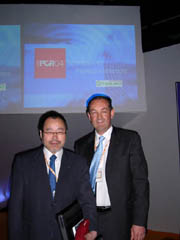
Professor Hamon |
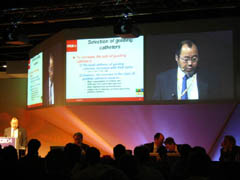
My Lecture |
Ferdinand Kiemeneij. Between these cases, each panelist had several lectures regarding TRI. I gave the lecture titled “Optimizing the backup support of the guiding catheters through TRI”. I had many questions from the audience. Jean’s case was a 45-years old male patient with triple vessel disease. Jean first placed a long BMS (bare metal stent: “TSUNAMI”) for the diffuse RCA (right coronary artery) lesion, and next placed another bare metal stent in the LCX (left circumflex artery) lesion. Finally, he placed a DES (drug eluting stent: “Cypher”) in the proximal LAD (left anterior descending artery). He is working in the Government Hospital “Clinique Pasteur”. In France, the Government strictly limits the use of DES. The use of DES is approved only for the lesion in the proximal LAD, or other vessels with diabetic patients or patients for whom CABG cannot be performed due to high surgical risk. In any case, only 1 DES is reimbursed by the insurance. If the doctor used 2 or more DES in one patient, the doctor or the hospital have to pay for the cost. There was an interesting and heated discussion between Jean and Josef. Many panel members criticized his strategy of placing only 1 DES in LAD. Against these criticisms, Jean said “This is the recommendation from the Government”. Josef: “It is surprising. This is the 1st time to hear from a famous Interventional Cardiologist telling that he will follow the recommendation. Interventional Cardiologists will never follow any regulation. If you believe that DES is better than BMS and the use of DES results in benefits for the patient, you have to use DES in all arteries.” Jean: “Actually, it is not a recommendation but a regulation by the Government. Thus, we have to follow it.”
Ferdinand’s case had double vessel diseases in LAD and LCX. He tried to show how easily he could engage the Kimny-type guiding catheter into the LCA (left coronary artery). However, the patient’s LCA originated from the upper side of the left coronary cusp. Unfortunately, he was not successful to put that catheter into LCA. Then, he tried JL3.5 and Fajadet’s curve. Again, they were not successful. Finally, he asked the panel member which guiding catheter should be used. I just answered it would be the left Amplatz-II. He tried the guiding catheter and could easily engage it.
After finishing this session, I took lunch in the seafood restaurant besides the convention center, where we can have “Moule des Marinaire”. It is the bowl of shell fish Moule boiled with white wine. It is not expensive but tasty.
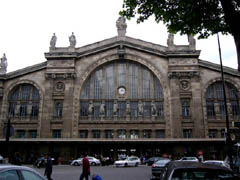
Paris North Station |
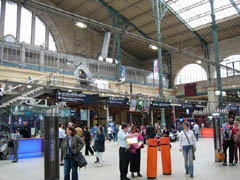
Inside of Paris Nord Station |
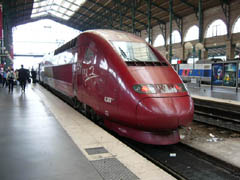
Thalys |
After having lunch, I went to Paris Gare du Nord. It is Paris North Station . Just at the time when I arrived at the station, I received a telephone call from Japan. That was from Dr. Rurus Suryawan, who visited our hospital for 3 months to learn how we were doing PCI in Japan and was coming back to Indonesia next day. He told me, “You would be successful. Do not worry!” Again, this encouragement gave me the power. Thank you. I took a train to Rotterdam from that station. The train was Thalys departing at 15:55 .

Thalys Tickets |
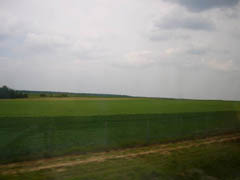
French Field |
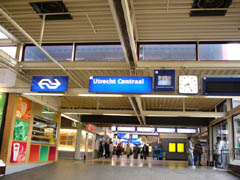
Utrecht Central Station |
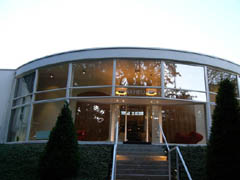
Restaurant PARKHEUVEL |
France has the honorable bullet train system called TGV. Thalys is actually one of TGV system.
TGV is going within France, or to Belgium, Switzerland and Italy. TGV is not going over Brussels. Thalys is going over
Brussels and to major cities in Netherlands. I traveled with one of my colleague doctors, Dr. Miyashita. My tickets were
provided from the organizing committee and the 1st class seats . From the train windows on the way, I could see only
wide fields in France . The Thalys train was supposed to arrive at Rotterdam Central Station at 19:08. However, there
was in-train announcement around 19:00: “Because of an accident near Rotterdam station, this train is diverted to the
other line. The passengers, who are going to Rotterdam or Schipol International Airport, are kindly requested drop at
Utrecht station, and take the connection trains.” No other explanation was made. I could not know how the accident was.
Later than 8:00 PM, we arrived at Utrecht Central Station . Because we had an appointment to have dinner together with
doctors in Erasmus Medical Center from 8:00 PM, we hurried and took a taxi to the hotel in Rotterdam. At the hotel entrance,
Dr. Aoki and Dr. Tsuchida were waiting for our arrival. It was already 10 minutes past 9:00 PM. We hurried to the restaurant,
where other doctors were waiting for us.
The restaurant was “Restaurant PARKHEUVEL”, which is the only one restaurant in Netherlands
given the award of 3 stars by Michelin. Dr. Eugene Mc Fadden, Dr. Peter Smith and other people were waiting for us.
We had dinner together. The food was French and very delicious in taste. The dinner was finished at 0:15 AM.
May 27 Thursday, 2004
While I was sleeping, I was dreaming. I was scared. I waked up every one hour. I had huge psychiatric pressure.
If my case would be successful, it would be OK. However, if I would fail, what would happen? In some way, I was
representing Japan. I was representing all of Japanese Interventional Cardiologists. Finally, I waked up at 5:00 AM.
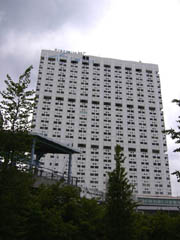
Erasmus Medical Center |
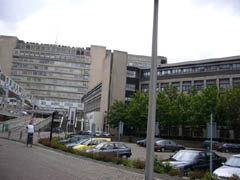
The Ward |
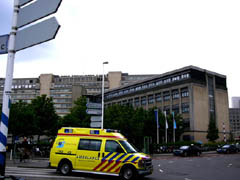
Ambulance Car |

RCA |

LCA |
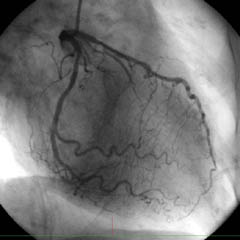
LCA RAO |
Why I came to Rotterdam? How the live case was assigned to me? I tell the story. I published a
Textbook for transradial approach last year together with Dr. Martial Hamon, Dr. Eugene Mc Faden and other famous
doctors mainly in France. I wrote one chapter in the book. My topic was about TRI for CTO lesions, which was based
on my article published in Catheterization and Cardiovascular Intervention in 2003 (Saito S, et al. Angioplasty for chronic
total occlusion by using tapered-tip guidewires. Catheter Cardiovasc Interv. 2003; 59: 305-11.). It was someday in February
or March this year when I received an e-mail from Dr. Mc Faden, in which he proposed me to demonstrate how to do PCI for
CTO lesions by transmitting a live case from Rotterdam to Paris during EuroPCR 2004. I quickly replied that I would do. Then,
my live case transmission was approved by Professor Jean Marco, Professor Patrick Serruys, all of the organizing committee
members of EuroPCR as well as Erasmus Medical Center. Thus, this live transmission was possible because I published
an article. I never wish to be a doctor, who does procedures but never publish their own works.
Dr. Aoki and Dr. Tsuchida came to pick up us at 09:45am at the lobby of our hotel. Erasmus Medical
Center is belonging to Erasmus University. The hospital main building is big . The ward building is also huge. The most
distinguished section of Erasmus Medical Center is obviously Thoraxcenter, which is conducted by Professor Patrick Serruys.
He is one of the most famous Interventional Cardiologists in the world. He has published many articles in the world-famous
medical journals. In Thoraxcenter, there are 3 catheter laboratories and many clinical research fellows working from various
countries. Dr. Aoki has been one of research fellows since last year. He came to Rotterdam from Mitsui Memorial Hospital,
Tokyo. Dr. Tsuchida just moved from Niigata University Hospital. He used to be my colleague several years ago.
Thoraxcenter is always busy for emergency patients . I heard that most of patients with acute myocardial infarction
were sent to Thoraxcenter from local hospitals and receive angioplasty, then sent back to the previous hospital on the
same day, because the capacity of CCU in Thoraxcenter is not enough.
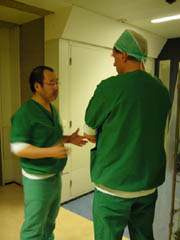
Discussion with Dr. Smith |
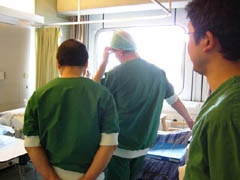
Visiting the Patient |
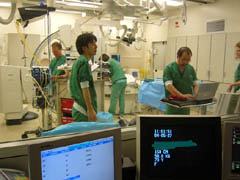
Setting Up My Computer |

Scrubbing |
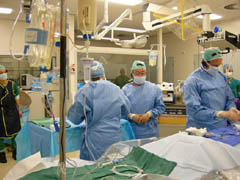
Thinking Strategy |
The case assigned to me was an old lady. She had 10 years history of effort angina, which exaggerated 3 months ago. Coronary angiograms showed a chronic total occlusion in the mid RCA and good collateral filling of the distal RCA from LCA. She also had moderate lesions both in proximal LAD and LCX . After the discussion with hospital staffs about the strategy , I and Dr. Peter Smith visited her bed to see her.
I set up my laptop computer in the room to show my presentation about PCI for CTO to the audience, just in case of finishing the procedure earlier. We started from the bilateral femoral artery puncture from 11:15 AM after scrubbing . The X-ray machine was biplane Siemens digital one. While Dr. Smith was doing puncture, I was seriously thinking about the strategy . Dr. Smith and the head nurse of the catheter laboratory assisted me. First, I passed a pressure guidewire (RADI) into LAD and LCX to check each FFR. They were 0.85 and 0.90, respectively. Thus, we decided that both lesions were not significant. I took 7 French AL 0.75 guiding catheter (Launcher), because I did not want to make any injuries by the guiding catheter tip to the proximal RCA, where I could see a moderate lesion. After taking several simultaneous bilateral coronary angiograms , we waited for the beginning of the live transmission to Paris, which was scheduled to be between 12:00 noon and 1:30 PM. This live transmission was scheduled as a part of “Back to Andreas” session.
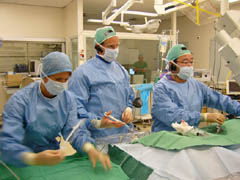
Head Nurse |
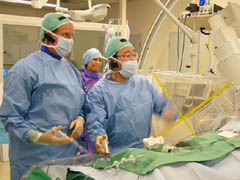
Bilateral Angiography |
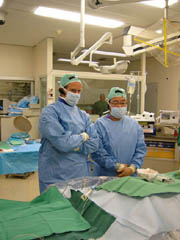
Waiting for Transmission |
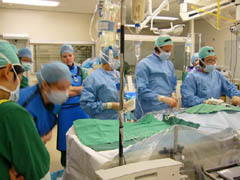
Doing PCI1 |
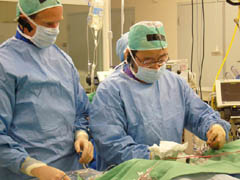
Doing PCI2 |
The transmission was suddenly started a few minutes past noon by the opening speech by Professor Patrick Serruys and Dr. Maurice Buchbinder. I was informed that the room was already full without any vacant seats. Dr. Smith briefly introduced the history of the patient’s disease and what we had already done. Then, I started from the shaping of the guidewire. I took a Transit microcatheter and a Magic-FA guidewire. I showed how to shape the tip of the guidewire for CTO lesions. While I tried to cross the lesion with this guidewire, a lady doctor from Thoraxcenter of Rotterdam showed outlines of PCI for CTO lesions in the auditorium. The guidewire went into the false lumen. Then, while I was leaving this guidewire within the RCA, I took a Conquest-Pro guidewire together with a Transit microcatheter . During my procedures, Patrick and Maurice explained several important tips to the audience and asked me several questions. By using a double guidewire technique, I finally succeeded in crossing the lesion by the Conquest-Pro guidewire. I felt a little bit relaxed and introduced to the audience the train accident, which we encountered the day before. Patrick’s comment was quite nice. He said “TGV is French product but not Netherlands’ product. Thus, we are not guilty.”
It was not easy to cross the lesion by a 1.5-mm Maverick balloon. After the dilation of the lesion with this balloon, I changed it to a 2.5-mm Maverick balloon. Thoraxcenter of Rotterdam is famous for a lot of clinical researches as to percutaneous coronary intervention. The clinical significance of FFR measurement was established by Patrick and his team. The more significant impact by Professor Serruys was the establishment of Quantitative Coronary Angiography (QCA). In the catheter laboratories of Thoraxcenter, on-line QCA measurement by using CAAS-II system is always ready. After the balloon dilatation, QCA was quickly performed. Since there was long dissection in RCA, I had to put stents. I was surprised to hear that no BMS was used during the past 2 years in Thoraxcenter. They are using DES for all of the lesions. Thus, the penetration of DES in Thoraxcenter is 100%, although it is only 25% on average whole around Netherlands. First, I placed a 3.0 x 33 mm TAXUS stent, and I placed the second stent (3.0 x 18 mm TAXUS) at the proximal site. After taking angiogram, I knew that the proximal lesion was not covered by the 2nd stent. I apologized to the audience for this my mistake. Patrick said “I will send you a bill for the 3rd stent.”
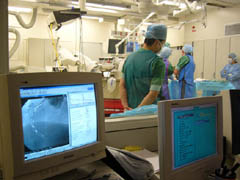
On-line QCA |
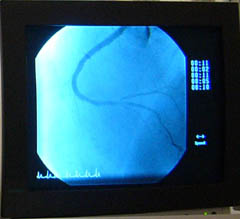
Final Angiogram |
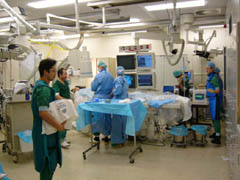
Finishing the Procedure |
I answered “OK, if I can by TAXUS in Japan, I will buy and send you it. However, unfortunately it is not sold in Japan. So, I cannot send you it, sorry.”
Anyway, I placed another TAXUS stent of 3.5 x 18 mm for the proximal RCA. Final angiogram was great. Because I finished the case earlier than the schedule, I spent 15 minutes to show how to do PCI for CTO lesions using my laptop computer.
After finishing everything, we hurried to the station. In front of the entrance, I took a photo together with Dr. Aoki and Dr. Miyashita.
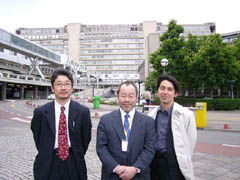
With Dr. Aoki and Dr. Miyashita |
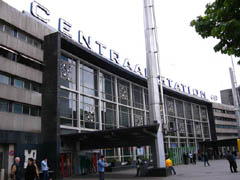
Rotterdam Central Station |
The train coming back to Paris departed at 14:24 from Rotterdam Central Station. This time, we first moved by a normal train of InterCity to Brussels Central Station, where we changed the train to Thalys going to Paris North Station. Finally, we arrived in Paris at 18:05 without any accident. I had a meeting with several doctors of APSIC (Asian-Pacific Society of Interventional Cardiology) in the Faculty Lounge within Palais de Congres from 7:00pm. The meeting was led by Dr. John Ormiston from New Zealand. We discussed about the next-morning live case transmission from APSIC country. The transmission of this year was from FuWai Hospital, Beijing, China. Professor Gao in FuWai Hospital already sent us the details of the cases by e-mail. John did the excellent leadership to decide what we had to discuss during the live transmission. At the end of our discussion, Professor Marco also joined us. He is always very anxious to enrich the live transmission from APSIC countries to EuroPCR course. Finally, the long hard day for me ended. Because this was the 1st experience for Dr. Miyashita to visit Europe, we went to Moulin Rouge after having Japanese noodle near Paris Opera Theater. The last show started from 11:30pm. Because of the lack of sleep and jet lag, I could not keep my eyes open. I came back to the hotel at 1:00 AM.
May 28 Friday, 2004
I waked up at 4:00 AM in order to prepare for a case presentation from 12:00 noon. EuroPCR organizing committee offered 2 hours to APSIC. APSIC session was started from 8:00 AM. There was 1-hour live transmission from FuWai Hospital. From the stage, I could identify almost 50 Chinese doctors watching the transmission in the auditorium. The 1st case had a critical narrowing at the distal end of the left main trunk. Professor Gao treated this patient elegantly by placing a DES following simultaneous kissing balloon angioplasty. Professor Ge Junbo was explaining the results of IVUS examinations from the catheter laboratory. The live transmission from Beijing was so successful that every audience as well as APSIC moderators was quite happy.
I called the cellular phone of Dr. Tejas Patel and told to meet at 11:00 AM in the Faculty Lounge. Dr. John Ormiston set up a case review session for bifurcation lesions and picked up 3 couples of doctors from APSIC. I and Tejas discussed a lot about the strategy of our presentation, and decided that I presented my case, and Tejas made short lecture for my strategy. The combination between me and Tejas was so nice that our presentation was most attractive and informative.

Paris City |
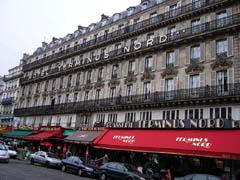
Hotel Terminus Nord |
After finishing all of my heavy duties during this-year EuroPCR meeting, again I had Moule des Marinaire in the same restaurant with Dr. Miyashita. Because the traffic in the Friday afternoon in Paris is always heavy, we left for the airport by 4:00 PM to take JL406 flight departing at 19:05 to Tokyo.
Paris is one of the most beautiful cities in the world.
May 29 Saturday, 2004
I arrived at New Tokyo International Airport of Narita at 13:30. Then, I directly moved to the Cardiovascular Institute at Roppongi, Tokyo, since I was again assigned to the last operator for PCI during the live demonstration held by the Institute. Fortunately, the traffic to Roppongi was not heavy. I could reach the hospital before 3:30 PM. I did TRI for the patient with previous bypass surgery. I placed 2 Cypher stents in this patient.
Thus, my busy week finally ended.
フランス-オランダ訪問記-I
湘南鎌倉総合病院 心臓センター循環器科
齋藤 滋
はじめに
今回の訪問記は冠動脈インターベンションに関する世界最大のライブデモンストレーションであるEuroPCR 2004での経験についてです。このライブデモンストレーションはフランスのパリで10年間以上に渡って続けられてきました。そして、毎年秋に米国首都ワシントンで開催されるTCTよりも規模が大きいものであり、参加者総数は1万人を超えます。私は1996年以来この会のFaculty Memberとなっています。実際、私は日本から最初のMemberです。今回組織委員会はこの会期中に私に4種類の重要な仕事を与えましたので、Facultyとしてとても忙しく過ごしました。そして、この中の一つは私にとって忘れがたい経験でした。1999年9月には私の湘南鎌倉総合病院からワシントンDCで開催されているTCTの会場に向けてライブデモンストレーションを飛ばしたことがあります。そして、2000年5月にはパリで開催されていたEuroPCRの会場に対してライブデモンストレーションを飛ばしたことがあります。今回私はオランダのロッテルダムからライブデモンストレーションを飛ばしたのです。これは本当に大変な経験でした。
私は成田空港を2004年5月25日午前11:10出発のJL405便でパリに向かいました。何人かの日本人医師も同じ便に乗られました。私が頭上の荷物入れにバッグをしまっている時、川崎社会保険病院の村松先生が私の席に来られ、「ロッテルダムからライブデモンストレーションを飛ばすのですってね。先生のことだからきっとうまく行きますよ。」と話しかけられてきました。もちろんロッテルダムからライブデモンストレーションを飛ばすことは大変な栄誉です。しかし、私は症例がうまくいかなかったらどうしよう、と怯えていました。私に割り当てられた症例は右冠動脈に慢性完全閉塞を有するお年寄りの女性でした。その慢性完全閉塞をクロスできるかどうか自信がありませんでした。ですから村松先生のこの励ましの言葉はとても救いになりました。本当に感謝しています。ありがとう。実際、私はこのライブデモンストレーションをうまくやり遂げるか否かで自分が国際的に名前の通ったPCI術者となるか、あるいは単なる日本国内のローカルな術者にしか過ぎないかが決まると思っていました。
11時間半の飛行の後、シャルル・ドゴール空港に到着しました。この長い飛行の間、私はたった30分間の睡眠をとっただけで、後は自分のラップトップを用いて講演スライドを作成していました。午後6時にメリディアン・ホテルにチェック・インしてから私は富永病院の高橋先生と共に行きつけの鮨屋「勇」で夕食をとりました。部屋に戻ったのは午前1時でした。
2004年5月26日水曜日

Palais de Congres |

Discussion |
講演の準備をするために午前4時に起きました。EuroPCRコースはPalais de Congresと呼ばれる大きな会議場で開催されています。私の最初の役割は、午前9時から11:30まで開催された経橈骨動脈冠動脈インターベンション・セッションでの座長および演者というものでした。このセッションの題名は、「注目セッション: 経橈骨動脈冠動脈インターベンションには限界が無い」というものでした。パネリストとして、米国Tiff Mann先生、ドイツJosef Ludwig先生、カナダGerald Barbeau先生など世界的に有名なRadialistの先生方をお呼びしました。皆、午前8時30分前には会場に集合してどのようにこのセッションを行っていくかを相談しました。私はHamon教授と共に座長を勤めました。また、このセッションにはフランス・ツールースにあるあの有名なパスツール病院からのライブデモンストレーション中継もありました。第1例目はFajadet先生、第2例目はKiemeneij先生によるものでした。この二つのライブデモンストレーションの合間にパネリストによる経橈骨動脈冠動脈インターベンションに関する色々な講演が行われました。私の講演演題は「経橈骨動脈冠動脈インターベンションにおいてガイディング・カテーテルのバック・アップをいかにとるか」というものでした。フロアーから多くの質問がありました。Fajadet先生の症例は45歳の3枝病変を有する男性患者さんでした。Fajadet先生はまず長い右冠動脈病変に対して長い通常ステントであるTSUNAMIを植えました。次に回旋枝病変に対して他の通常ステントを植えました。そして、最後に左冠動脈前下行枝近位部病変に対して薬剤溶出性ステント(DES)であるCypherを植えました。彼が働いているのは政府系公立病院パスツール病院です。フランスではDESの臨床使用に対してきつい政府による縛りがあります。左冠動脈前下行枝近位部病変、あるいは糖尿病患者さんにおける他の冠動脈病変、あるいは冠動脈バイパス手術不能症例における病変に対してしかDESの使用は許されていません。しかも一人の患者さんに対してただ一つのDESのみが保険償還で許されます。もしも一人の患者さんに二つ以上のDESを使ってしまったならば、その医者ないしは病院がそのコストを払わねばなりません。ここでFajadet先生とLudwig先生の間で面白い議論が展開されました。Fajadet先生が、DESを左冠動脈前下行枝病変にしか植え込まないことに対して皆が異議を唱えました。これに対してFajadet先生は、「DESを一人の患者さんに対して一つしか用いない、というのは政府からの要請だ。」と、答えました。これに対して、Ludwig先生は、「へえーっ、とっても驚き! あなたのように有名な循環器内科医がそのような要請に従うなんて、今までそんなことあったかね。DESがBMSよりも患者さんのために良いと思うのだったらば、3枝全部にDESを植え込むべきだと思うよ。」と挑発的に反論しました。Fajadet先生は、「”要請”と言ったけれど、これは政府による決まりだから、だからそれに従わねばならない。」と、答えました。

Professor Hamon |

My Lecture |
Kiemeneij先生の症例は左冠動脈前下行枝と左回旋枝に病変がある二枝病変の患者さんでした。Kiemeneij先生は
自分が考えたKimneyカテーテルがどれほど簡単に左右冠動脈に挿入できるかを示したかったようです。でも、その患者さんの左冠動脈は通常よりも
上方から分岐するタイプでしたので、残念ながら左冠動脈に挿入することができませんでした。そこで、彼はガイディング・カテーテルをJL3.5あるいは
Fajadet型に変更しましたが、それでも左冠動脈に挿入できませんでした。結局、彼は我々にどのカテーテルが良いか?と、聞いてきましたので、
私はAL-IIが良いだろう、と答えました。結果的にはこのガイディング・カテーテルが簡単に挿入可能でした。

Paris North Station |

Inside of Paris Nord Station |

Thalys |
このセッションを終えてから私は学会場の目の前のレストランで、ムール貝の白ワイン蒸し、”Moule des Marinaire”を食べました。
本当に安いけどおいしいです。

Thalys Tickets |

French Field |

Utrecht Central Station |

Restaurant PARKHEUVEL |
昼食を終えてから私は、パリ北駅に向かいました。ロッテルダムに向かう汽車に乗るためです。ちょうど駅に着いた時に、
日本から電話がありました。それはRurus先生からのものでした。彼は3ヶ月間われわれの病院でPCIの勉強をしていて、翌日インドネシアに帰る
ところでした。彼は私に「心配しないで、きっとうまくいくよ!」と励ましてくれました。ありがとう。その汽車というのは15:55発の”タリス”でした。
フランスにはTGVという世界に誇るべき弾丸列車があります。”タリス”というのはTGVそのものですが、TGVというのはあくまでもフランス、ベルギー、
スイスあるいはイタリアまで行く列車のことです。これに反して”タリス”というのはブリュッセルを越えてオランダ主要都市に向かう列車のことです。
私は部下の宮下君とこの列車に乗りました。私の切符は学会が用意して下さった一等座席のものでした。車窓の風景はフランスの広大な草原
ばかりでした。我々の乗った汽車はロッテルダム中央駅に19:08に到着する筈でした。しかし、19:00頃に突然車内アナウンスがありました。それは、
「この列車はロッテルダム近郊の事故のため行き先を変更します。ロッテルダムやスキポール空港に向かう乗客の皆様方はユトレヒト駅で降りて下さい。
接続便が来ます。」というものでした。その後、何の説明もありませんでした。もう午後8時を過ぎてから我々はそのユトレヒト駅に到着しました。
その夜は午後8時からエラスムス大学病院の先生方と夕食を一緒にとる約束でしたので接続便を待たずにタクシーでロッテルダムに移動しました。
もう午後9時10分ぐらいになってやっとホテルに着くことができましたが、ロビーでは青木先生と土田先生が我々を待っていました。そして、
レストランに急ぎました。
約束のレストランは”ParkHeuvel”という名前のレストランでした。ここはオランダ国内唯一のミシェラン三ツ星レストランです。
Mc Faden先生、Smith先生達が私たちの到着を待っていました。食事はフランス料理でしたがとてもおいしいものでした。結局、
夕食が終わったのは午前0時15分くらいになっていました。
2004年5月27日木曜日
眠っている間も夢を見ていました。恐れていました。1時間毎に目を醒ましました。精神的重圧は大変なものでした。うまくやり遂げれば良いけど、
もしもうまく行かなかったらば一体全体どんなことになるか? ある意味で日本の循環器内科医の代表として手技をするのだから・・・・。結局、
午前5時には起きてしまいました。

Erasmus Medical Center |

The Ward |

Ambulance Car |

RCA |

LCA |

LCA RAO |
どうしてロッテルダムに来ることになったかと言えば、それは次のような次第でした。昨年私はHamon先生、
Mc Faden先生や他の有名な主としてフランスの先生方と共に経橈骨動脈アプローチに関する教科書を出版しました。私が担当したのは
慢性完全閉塞に対する経皮的冠動脈インターベンションの章でした。それというのも2003年のCatheterization and Cardiovascular
Intervention誌に慢性完全閉塞に対するPCIの論文を掲載したからです(Saito S, et al. Angioplasty for chronic total occlusion by
using tapered-tip guidewires. Catheter Cardiovasc Interv. 2003; 59: 305-11.)。今年の二月か三月のことでしたが、突然その
Mc Faden先生からメールが入りました。そのメールによれば今年のEuroPCRにおいてロッテルダムから慢性完全閉塞に対するPCIの
ライブデモンストレーションを行ってみてはどうか? というものでした。これに対して私はすぐにOKと返答しました。そして、この計画はMarco先生、
Serruys先生、他のEuroPCR組織委員会のメンバーそしてエラスムス大学病院より承認されました。ですから、結局のところ今回の
私のライブデモンストレーションは私が論文を出版したから出来たことなのです。私としてはただ手技を行うだけで論文を書かないような
医者にはなりたくはありません。
青木先生と土田先生の2人は午前9:45にホテルのロビーに迎えに来られました。エラスムス大学病院はエラスムス大学
に付属します。建物は巨大であり、病棟も広大です。エラスムス病院で最も有名な部門はSerruys教授率いる経皮的冠動脈インターベンション
を専門とするThoraxcenterです。教授はこの分野において世界で最も有名な先生です。これまでにたくさんの論文を著名な医学雑誌に出版
してこられました。Thoraxcenterにはカテラボが3室あり、さまざまな国々から研究者が常に集まっています。青木先生は三井記念病院より
一年前からここに研究者として来られたそうです。土田先生は最近、新潟大学よりここに研究者として来られたのですが、数年前には私の下
で研修されたことがあります。Thoraxcenterにはいつも救急車が患者さんを運んできます。地域の病院より転送された急性心筋梗塞患者さんの
多くはカテ室でPCIを受けた後、そのまま同じ日に元の病院に送り返されるそうです。ThoraxcenterのCCUは一杯です。

Discussion with Dr. Smith |

Visiting the Patient |

Setting Up My Computer |

Scrubbing |

Thinking Strategy |
私に割り当てられた症例はお年寄りの女性でした。10年前から狭心症があり、3ヶ月前から特に強くなったそうです。
冠動脈造影の結果では、右冠動脈に慢性完全閉塞病変があり、その末梢は左冠動脈より良く造影されます。また、左前下行枝と左回旋枝
の近位部にも中等度の病変がありました。病院スタッフとPCI戦略について話し合った後、Smith先生と共に患者さんに挨拶に行きました。
手技が早く終わった場合に備えて、慢性完全閉塞に対する戦略の講義を行えるように私は自分のコンピューターをカテ室内
に準備しました。手洗いの後、午前11:15頃より両側大腿動脈穿刺からスタートしました。レントゲンの機械はSiemensの二方向デジタルでした。
Smith先生が穿刺をされている間、私はもう一度戦略について考えました。私を助手して下さったのはそのSmith先生とカテ室の看護師長さんでした。
まず、Pressure wireを左前下行枝と左回旋枝に挿入し、FFRをチェックしました。その結果は0.85あるいは0.90といったものでしたので、
これらの病変はPCIの必要無し、と判断しました。右冠動脈近位部にも病変があったので、ガイディング・カテーテル先端による損傷を嫌って、
7FrのAL0.75ガイディング・カテーテルを選択しました。左右同時冠動脈造影を行った後、正午12時開始、午後1時30分終了のパリへの
ライブデモンストレーション中継開始を待ちました。このライブデモンストレーションは「グルンツッヒを偲んで」というセッションの一部でした。

Head Nurse |

Bilateral Angiography |

Waiting for Transmission |

Doing PCI1 |

Doing PCI2 |
正午を数分回ってからSerruys先生とBuchbinder先生の呼びかけにより突然中継がスタートしました。会場は満席で空いた
座席は無かったそうです。Smith先生が簡単に病歴紹介と、これまでに行った手技について説明されました。そして私はガイドワイヤーの先端カーブ
形成からスタートしました。最初にTransitとMagic-FAガイドワイヤーを選択しました。慢性完全閉塞に対してはどのような先端形状にすべきかを
紹介しました。私が病変通過に一生懸命になっている間にThoraxcenterのお医者さんの一人、女性が慢性完全閉塞に対するPCIの概略を
スライドで説明されました。Magic-FAは偽腔に入っていったため、ガイドワイヤーをそこに残したまま、Conquest-Proを取り出しました。
これらを行っている間、Serruys先生とBuchbinder先生のお二人は技術的に重要な点をいくつか紹介されると共に私にも質問をされました。
ダブル・ガイドワイヤー・テクニックを行うことによってConquest-Proは真腔を捉えることができました。そこでやっと少しリラックスしたので、
来るときの列車トラブルについて話しました。Serruys先生のコメントはとても面白かったです。それは「TGVはフランス製でオランダ製ではない。
だから私は悪くないよ。」というものでした。

On-line QCA |

Final Angiogram |

Finishing the Procedure |
1.5mmのMaverickバルーンはなかなか病変を通過できませんでした。病変をこのバルーンで拡張した後、2.5mmのMaverick
に交換しました。Thoraxcenterで行われた重要な業績の一つが、FFRの臨床的意義を確立したことです。そしてSerruys先生が挙げられた
それよりも重要な業績が定量的冠動脈造影(QCA)です。Thoraxcenterカテ室ではオンラインQCAの設備が備わっていますので、バルーン拡張後
すぐにQCAが行われます。右冠動脈には長い解離ができていましたので、ステントを入れる必要がありました。何とこの2年間Thoraxcenterでは、
驚くべきことに通常ステント(BMS: Bare Metal Stent)は一つも用いられておらず、薬剤溶出性ステント(DES: Drug-Eluting Stent)しか使われて
いないそうです。ですからThoraxcenterでのDES浸透率は100%ということになりますが、オランダ全体ではたかだか25%ということです。まず、
3.0 x 33mmのTAXUSを植え込み、次いで3.0 x 18mmのTAXUSを植えました。しかし、右冠動脈近位部病変が完全にはカバーできて
いませんでしたので、「申し訳無い」と、謝りました。Serruys先生は、「請求書を送るよ。」と、言われました。そこで私は、「OK、日本国内でこの
TAXUSを買えるのだったらば、買って返すよ。でも、残念ながら売っていないから。」と、答えました。結局、右冠動脈近位部にもう一つの
3.0 x 18mm TAXUSステントを植え込みました。最終造影はとても見事なものでした。予定よりも早く手技が終了したので、私は自分の
コンピューターでCTOに対するPCIの講義を15分間ばかり行いました。

With Dr. Aoki and Dr. Miyashita |

Rotterdam Central Station |
全て終了してから、駅に急がねばなりませんでした。病院玄関前で、青木先生、宮下君と共に記念写真を撮りました。
パリに戻るために、午後2時24分ロッテルダム中央駅発のブリュッセル行きInterCityに乗らねばなりませんでした。これは高速列車ではありません。
ブリュッセル中央駅でThalysに乗り換え、午後6時5分に今度は事故も無く、再びパリ北駅に戻ってきました。午後7時からはAPSICの先生方と
Faculty Loungeで打ち合わせする約束がありました。ニュージーランドのOrmiston先生が中心になって、翌朝行われる予定の北京阜外病院からの
APSICライブデモンストレーションについて相談しました。既に、阜外病院高先生から症例の詳細が電子メールで送られてきていました。
Ormiston先生はライブデモンストレーションの最中に何を話すべきかを決められました。議論も終わりかけた頃にMarco先生も加わりました。
Marco先生はAPSICの国々からのライブデモンストレーションをいかに充実するかに心血を注いで来られました。そして、このハードな日が終わりました。
今回のヨーロッパ訪問は宮下君にとって初めてのことでしたので、オペラ座界隈でラーメンの夕食をとった後、私たちはムーラン・ルージュに行きました。
最後のショーは午後11時半から始まりましたが、何しろ睡眠不足と時さ呆けのために目を開けておくことが出来ませんでした。
ホテルに戻ったのは午前1時でした。
2004年5月28日金曜日
午前4時に起きて、正午からの症例紹介の準備をしました。EuroPCR組織委員会はAPSICのために2時間を割り振ってくれました。
APSICセッションは午前8時から始まり、阜外病院からの1時間のライブデモンストレーションがありました。壇上から見ると会場には50名ぐらいの
中国からのお医者さんが見に来られていました。第1例目は左主幹部分岐部近くに狭窄のある症例でした。高先生が治療され、DESを植え込み
、最後にKissing balloonを行って終了しました。カテ室内のIVUSコメンテーターは葛教授が行われました。この北京よりのライブデモンストレーション
中継は成功裏に終了し、皆が満足しました。
終了してから私はPatel先生の携帯電話を鳴らしました。そして、Faculty Loungeで午前11時に落ち合うことに決めました。
Ormiston先生はAPSICから3組の医者コンビを選択し、分岐部病変の症例紹介セッションを企画されました。私はPatel先生とどのように
症例紹介をするかを考えました。結局、私が症例の紹介を行って、Patel先生が解説をすることに決めました。Patel先生と私の連携はとてもうまく
行きましたので、この3組の症例紹介の中ではピカイチでした。

Paris City |

Hotel Terminus Nord |
今年のEuroPCRでの辛い義務の全てを終了しました。また、先日のレストランで宮下君とムール貝を食べました。
金曜日午後のパリはひどい交通渋滞ですので、午後7時05分発成田行きのJL406便に乗るために午後4時には出発しました。
パリは世界の中で最も美しい都市の一つです。
2004年5月29日土曜日
午後1時半に成田空港到着しました。それから六本木にある心臓血管研究所にまっしぐらに急ぎました。この日はこの病院から別の
ライブデモンストレーションが開催されており、私は最後の術者の予定でした。幸い交通渋滞も無かったので、午後3時半前には病院に
到着しました。冠動脈バイパス手術術後の患者さんに対してTRIで手技を行い、Cypherステントを二個植え込んで終了しました。
こうして、忙しい一週間が終わりました。
|

































